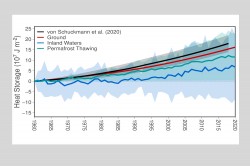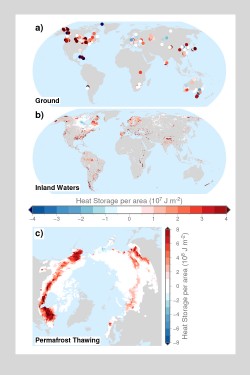Press Release, 31. May 2023
Underestimated Heat Storage
Calculations show that the thermal energy stored by land masses has increased significantly
There are many effects of climate change. Perhaps the most broadly known is global warming, which is caused by heat building up in various parts of the Earth system, such as the atmosphere, the ocean, the cryosphere and the land. 89 percent of this excess heat is stored in the oceans, with the rest in ice and glaciers, the atmosphere and land masses (including inland water bodies). An international research team led by the Helmholtz Centre for Environmental Research (UFZ) has now studied the quantity of heat stored on land, showing the distribution of land heat among the continental ground, permafrost soils, and inland water bodies. The calculations, published in Earth System Dynamics, show that more than 20 times as much heat has been stored there since the 1960s, with the largest increase being in the ground.

Photo: Author(s) 2023

Photo: Author(s) 2023
The increase in anthropogenic greenhouse gases in the atmosphere prevents the emission of heat into space. As a result, the earth constantly absorbs more heat through solar radiation than it can give back off through thermal radiation. Previous studies show where this additional energy is stored: primarily in the oceans (89 percent), but also in the land masses of the continents (5-6 percent), in ice and glaciers (4 percent) and in the atmosphere (1-2 percent). However, this knowledge is incomplete: For example, it was previously uncertain just how this additional heat was distributed in the continental landmasses.
The research team, headed by the UFZ and with the participation of scientists from the Alfred Wegener Institute (Helmholtz Centre for Polar and Marine Research (AWI)), Vrije Universiteit Brussel and other research centres, was able to quantify more precisely how much heat has been stored in the continental land masses between 1960 and 2020. The result: continental landmasses have absorbed a total of 23.8 x 1021 Joules of heat between 1960 and 2020. For comparison: This corresponds to roughly 30 times the electric power consumption(*) of Germany over in the same period. Most of this heat, roughly 90 percent, is stored up to 300 metres deep in the earth. 9 percent of the energy is used to thaw permafrost in the Arctic and 0.7 percent is stored in inland water bodies such as lakes and reservoirs. "Although the inland water bodies and permafrost store less heat than the ground, they have to be monitored continuously because the additional energy in these subsystems causes significant changes in ecosystems," says UFZ researcher and lead author of the study Francisco José Cuesta-Valero.
The scientists also demonstrated that the quantity of heat stored in the ground, in permafrost and in lakes has been increasing continuously since the 1960s. For example, a comparison of the two decades from 1960-1970 and from 2010-2020, this quantity increased by nearly 20 times from 1.007 to 18.83 x 1021 Joules in the ground, from 0.058 to 2.0 x 1021 Joules in permafrost regions and from -0.02 to 0.17 x 1021 Joules in inland water bodies. The researchers used more than 1,000 temperature profiles worldwide to calculate the quantities of heat stored at depths of up to 300 metres. They used models to estimate the thermal storage in permafrost and inland water bodies. For example, they combined global lake models, hydrological models and earth system models to model the waters. They estimated thermal storage in permafrost with a permafrost model that accounts for various plausible distributions of ground ice in the Arctic. "Using models enabled us to compensate for the lack of observations in many lakes and in the Arctic and to better estimate the uncertainties due to the limited number of observations," explains Francisco José Cuesta-Valero.
Quantifying this thermal energy is important because its increase is associated with processes that can change ecosystems and can thus have consequences for society. This applies, for example, to the permanently frozen ground in the Arctic. "Although the quantity of heat stored in the permafrost may only comprise nine percent of continental heat storage, the increase over recent years further promotes the release of greenhouse gases such as carbon dioxide and methane due to thawing of permafrost," says Francisco José Cuesta-Valero. If the thermal energy stored in the ground increases, the surface of the earth heats up, thereby placing the stability of the carbon pool in the ground at risk, for example. In agricultural areas, the associated warming of the surface could pose a risk to harvests and hence the food security of the population. In inland water bodies, the changed thermal state could affect the dynamics of the ecosystems: Water quality worsens, the carbon cycle is thrown off; algal blooms increase and in turn affect oxygen concentration and primary productivity, thereby affecting fishery production.
Therefore, co-author Prof. Dr. Jian Peng, head of the UFZ Remote Sensing Department, summarizes: "It is important to more precisely quantify and monitor how much additional heat is absorbed by the continental land masses. This is a key metric for understanding how changes in natural processes resulting from heat storage will affect humans and nature in the future."
(*)We corrected the number. The earlier version incorrectly stated: "This corresponds to roughly 1800 times the electric power consumption of Germany over in the same period." We apologise.
Publication:
Francisco José Cuesta-Valero, Hugo Beltrami, Almudena García-García, Gerhard Krinner, Moritz Langer, Andrew H. MacDougall, Jan Nitzbon, Jian Peng, Karina von Schuckmann, Sonia I. Seneviratne, Wim Thiery, Inne Vanderkelen, and Tonghua Wu. Continental Heat Storage: Contributions from the Ground, Inland Waters, and Permafrost Thawing. Earth System Dynamics. https://doi.org/10.5194/esd-14-609-2023
Further information
Francisco José Cuesta-Valero
UFZ Department of Remote Sensing
francisco-jose.cuesta-valero@ufz.de
Prof. Dr. Jian Peng
Head of UFZ Department of Remote Sensing
jian.peng@ufz.de
UFZ press office
Susanne Hufe
Phone: +49 341 6025-1630
presse@ufz.de
In the Helmholtz Centre for Environmental Research (UFZ), scientists conduct research into the causes and consequences of far-reaching environmental changes. Their areas of study cover water resources, ecosystems of the future, environmental technologies and biotechnologies, the effects of chemicals in the environment, modelling and social-scientific issues. The UFZ employs more than 1,100 staff at its sites in Leipzig, Halle and Magdeburg. It is funded by the Federal Government, Saxony and Saxony-Anhalt.
www.ufz.deThe Helmholtz Association contributes to solving major challenges facing society, science and the economy with top scientific achievements in six research fields: Energy; Earth and Environment; Health; Key Technologies; Matter; and Aeronautics, Space and Transport. With some 39,000 employees in 19 research centres, the Helmholtz Association is Germany’s largest scientific organisation.
www.helmholtz.de